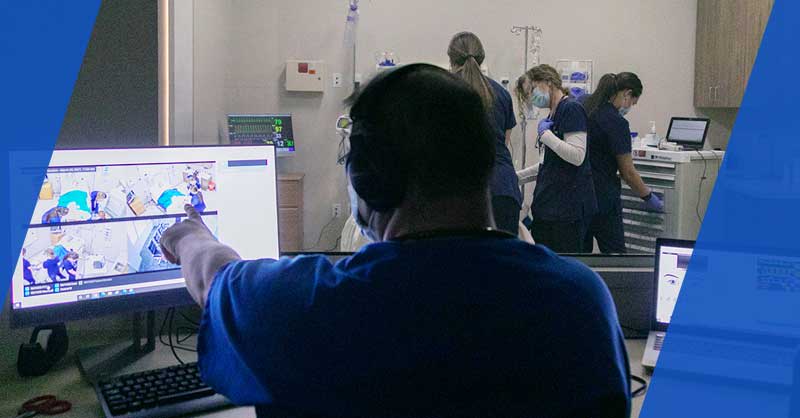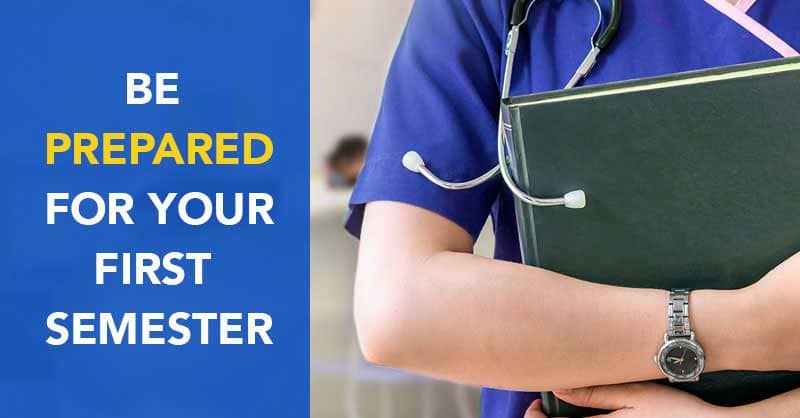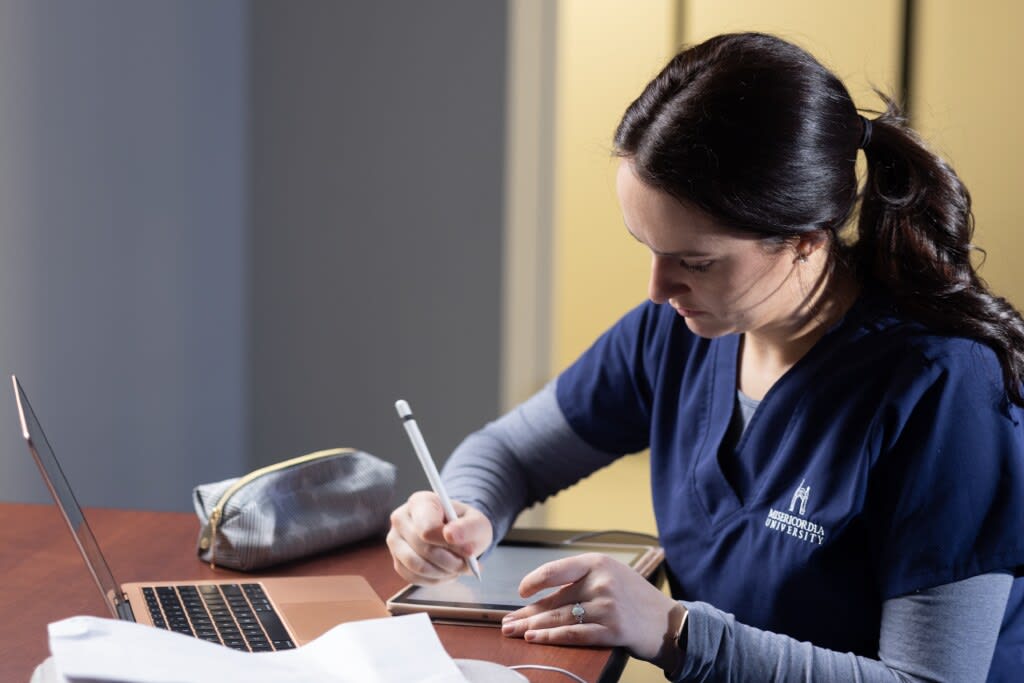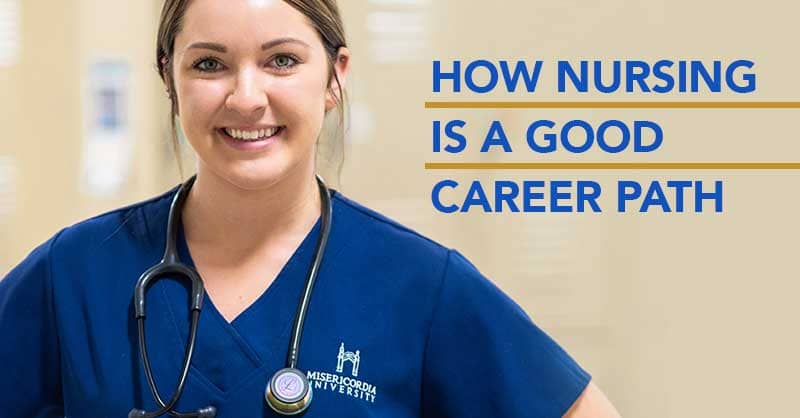How to Become a Telehealth Nurse: 6 Steps to a New Career
Each blog post is dated and contains accurate information as of that date. Certain information may have changed since the blog post publication date. If you would like to confirm the current accuracy of blog information, please visit our ABSN overview page or contact admissions at (866) 885-6337.
How to become a telehealth nurse consists of six steps. Apply and get accepted into nursing school. Then earn your BSN, apply for licensure, and pass the NCLEX. After receiving your license, work in bedside nursing for a few years. After getting experience in your field, apply for telehealth jobs.

In recent years, remote jobs have become increasingly popular. Working remotely offers flexibility and a comfortable workspace without having to commute. But can nurses work from home? They can, thanks to telehealth. Telehealth involves virtual doctor appointments and other health care that occurs digitally rather than face-to-face.
If you’re interested in pursuing a nursing career within the telehealth sphere, the process is actually simpler than it seems. How to become a telehealth nurse can be broken down into six steps, which we’ll discuss in detail for you.
At Misericordia University, our Accelerated Bachelor of Science in Nursing (ABSN) program near Pittsburgh prepares students to take on diverse nursing careers, including those in telehealth. Our 16-month accelerated nursing program is available to students with at least 60 non-nursing college credits or a bachelor’s degree, so it’s a great path for making the transition to nursing.
Now let’s get into the six steps of how to become a telehealth nurse so you know exactly how to proceed with planning your nursing career.
1. Take Prerequisites and Apply to Nursing School
The first step in how to become a telehealth nurse is to apply for a nursing program. Though limited job options are available to nurses with an associate degree or a nursing diploma, the best and most diverse opportunities are available to nurses with a bachelor’s degree.
The ABSN program at Misericordia is a great option for earning a BSN in less time by leveraging your prior education. Before applying to the accelerated nursing school, you’ll need to complete various science prerequisite courses to ensure you have a solid knowledge base before starting the nursing curriculum.
Then, once you’re finishing up your prerequisites, you can apply for the ABSN program. We offer three start dates each year, so you don’t have to wait to apply. For the application, you’ll need to complete an online application and submit the required documents, including your transcript.

Interested in tips for increasing your chances of admission? Learn more about how to get into an accelerated nursing program.
2. Earn Your BSN
Once you receive notice of acceptance into the ABSN program, the next step is putting in the work to earn your degree. At Misericordia, our accelerated nursing curriculum consists of a mix of:
- Foundational online courses.
- In-person nursing simulation and skills labs.
- Diverse clinical rotations at regional health care facilities.
With Misericordia’s online courses, you’ll get to have greater flexibility with when and where you study. In nursing labs you’ll develop hands-on, applicable skills and learn how to respond in nursing scenarios. Finally, with clinical rotations, which begin the second semester of the program, you’ll get to put all your knowledge to use and learn how real-world nursing works.
Accelerated nursing programs are fast-paced, and you will need to work hard. BSN programs prepare you to practice as a generalist nurse, so you’ll cover a wide range of content.

Want to know what to expect in an accelerated nursing program? Learn more about starting Misericordia’s ABSN program.
For telehealth nurses, learning the methodologies, procedures, and skills of a bedside nurse is vital. You’ll need to be confident in your knowledge and abilities to be a trustworthy health care provider, especially from afar, and that begins with a comprehensive, high-quality nursing education.
3. Apply for Your Nursing License
After graduating from nursing school, the next step in the process of becoming a telehealth nurse is to receive your nursing license. Licensing is required before you start working as a registered nurse. Your license is given out by the state where you live or work, so consult your state’s board of nursing website for information about your state’s requirements.
Where you get your license matters, especially for a nurse aiming for a career in telehealth. That’s because more than half the states in the country have joined the Nurse Licensure Compact (NLC). In NLC states, you can get a compact multistate nursing license, which means you can work as a nurse in any other NLC state without a new license.
One of the advantages of earning a BSN at Misericordia is that Pennsylvania has joined the NLC, so if you stay in the state after graduation, you’ll be able to get a compact nursing license. Having your license transfer across state borders will come in handy when you start working in telehealth, as your job may involve caring for patients in multiple states.
4. Take the NCLEX
After you apply for your nursing license, you will get approval to take the National Council Licensure Examination for Registered Nurses (NCLEX-RN). The NCLEX is the national board exam that you’ll need to pass before receiving your official nursing license.
The NCLEX is a comprehensive assessment of your nursing education, requiring a significant amount of dedicated study. That’s because it challenges you to choose the best answer, even when there’s more than one answer that’s technically correct.

Most students start studying during the last semester of the ABSN program. Then they spend the month or two after graduation studying before taking their exam. After you’ve passed the NCLEX exam, you’ll get notification of your approved nursing license, and you’ll be able to start your first professional nursing job.
5. Gain In-Person Nursing Experience
Before getting a job as a telehealth nurse, you’ll need to start by working in a bedside nursing role. It’s important to refine your nursing skills and get comfortable with the nursing workflow before you start nursing from a distance. Most health care employers want to see at least a few years of bedside nursing experience before they’ll consider you for a telehealth role.
The amount of clinical experience needed depends on what type of telehealth role you plan to enter. For example, if you aspire to work as a telehealth nurse for critical care, you’ll likely need more experience and certifications before you’re qualified for those roles. However, if you want to work as a telehealth nurse for a clinic or on a general hospital unit, you’ll likely only need around three years of experience.

Is nursing a good career? Learn about the advantages of becoming a nurse.
6. Apply for Telehealth Jobs
Once you’ve gained suitable experience to be qualified for telehealth jobs, the final step is to start looking for your ideal role and send in your applications. The great thing about telehealth jobs is you can often work remotely from anywhere in the country. Now you’re ready to begin nursing in the emerging field of technology-assisted health care.
What is Telehealth Nursing Like?
Telehealth nursing is a fantastic opportunity for nurses to provide care using technology such as video and digital monitoring devices. Telehealth nurses get to care for diverse patient groups in multiple locations while maintaining a flexible work environment. This emerging nursing field is only going to grow from this point on, so it’s a field ripe with opportunity and career potential.
A career in telehealth nursing provides a comfortable lifestyle, earning an average of $72,201 per year, according to ZipRecruiter. Plus, many employers offer benefits packages comparable to what they offer traditional nurses.
Not only does telehealth nursing offer a well-paying career, but it also provides many lifestyle benefits including work-life balance, flexible scheduling, and work-from-home opportunities.
What Does a Telehealth Nurse Do?
The life of a telehealth nurse can take many forms, as there is a broad range of responsibilities depending on where you work. A few examples of the roles of telehealth nurses include:
- Conducting patient assessments and interviews.
- Monitoring vital signs and patient stability.
- Treating and consulting with patients on routine health care needs.
- Assisting and advising small, rural nursing staffs care with their higher acuity patients.
- Monitoring and analyzing medical device data.
Ready to Start Your Nursing Journey?
If you’re looking to get started in a meaningful career where you can make a difference in countless people’s lives, there’s no better choice than nursing. At Misericordia, our accelerated BSN program is the ideal fit for students with 60 college credits or a non-nursing bachelor’s degree.
After acceptance into the program, you can earn your degree in as few as 16 months. We even offer multiple start dates each year, so you can graduate and start working as a nurse sooner.

Learn about more nursing career options available after you earn your BSN.
There is no better time than now to make a positive career change. Reach out to an admissions counselor today to learn more about how Misericordia’s ABSN program aligns with your goals.
